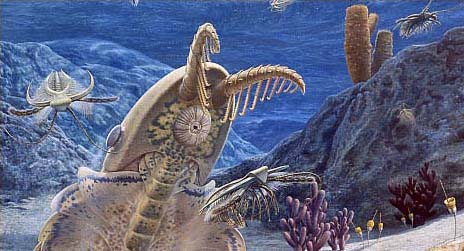 |
 |
 |
 |
 |
Produced
by the Population Genetics and Evolution class, Furman University |
||||
 |
 |
 |
 |
 |
Produced
by the Population Genetics and Evolution class, Furman University |
||||
 |
The
Cambrian: Wiwaxia |
 |
||
| Wiwaxia
was first discovered in 1899 in the Burgess Shale Formation (Waggoner
and Collins 1994). The first findings only consisted of spines and broken
pieces, but whole specimens were found shortly thereafter. To date, 140
specimens have been found. This organism had two rows of spines on its
back which are thought to have served as protection from predators like
Anomalocaris. There is evidence from the broken spines that have
been found that this animal was sometimes preyed upon. The rest of its
upper body was covered in small overlapping plates (known as sclerites)
that were attached with a root-like structure. It also appears that Wiwaxia
grew by molting their sclerites, and that they ranged from 6-50 mm in
length. (Fossil Museum 2010). Their sclerites and spines are not chitinous
as would be expected; they may be made of cartilage, but it is not known
for certain. The ventral side of Wiwaxia was smooth like a slug,
but they had no distinct head or tail region from the top view (Wikipedia
2009). They did have an anterior jaw with two rows of teeth, meaning that
they were bottom feeders (Fossil Museum 2010). Some paleontologists suggest
that these feeding structures resemble the radula of modern molluscs.
Their intestinal tract seemed to run straight from their head to the rear,
but nothing is known about their respiratory system. Wiwaxia
also have no signs of eyes or tentacles, so it is inferred that they relied
on smell and taste to survive (Wikipedia 2009). Page by Lindsay Gerzel |
 |
| Wiwaxia fossil and reconstruction. Photo Credit: Royal Ontario Museum | |
|
Waggoner BM, Collins AG. 1994. Cambrian: Life. University of California Museum of Paleonnotology. Accessed January 31, 2010. Fossil Museum. 2010. Rare Wiwaxia enigmatic soft body animal fossil. Accessed January 31, 2010. Wikipedia. 2009. Wiwaxia. Accessed January 31, 2010. |